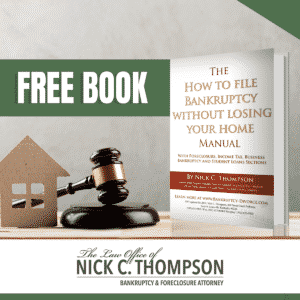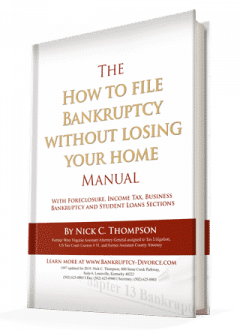Again, no one should assume that their student loan is not dischargeable in bankruptcy. The fact is, every year about 500 people nationwide get student loan discharges. First, you have to prove that you do not have enough income to cover basic health care and essential food, shelter, and clothing if you continue to pay your student loans. In addition, you must file an adversary proceeding, which is a separate lawsuit in bankruptcy to obtain the undue hardship discharge for student loans.
Interestingly, it has been done by many who worked hard to obtain it when the conditions were right. Three studies show 50% of the time when a debtor asks for an undue hardship discharge, he is given one. Even if the entire debt is not discharged, a partial discharge that eliminates 50% to 90% of the debt is possible.
The Sixth Circuit Courts are the most likely to uphold Partial Student Loan Hardship Discharge. Read these cases to learn more.
 Cases Pertaining to Partial Student Loan Hardship Discharge
Cases Pertaining to Partial Student Loan Hardship Discharge
In Re Saxman, — F.3d — 2003 WL 1870489 (9th Cir. 2003)
In this case, the Bankruptcy Court determined that a portion of the debtor’s student loan debt would impose an “undue hardship” because it could not discharge a portion of the debt that caused the hardship it discharged the entire debt. The District Court reversed and ordered the bankruptcy court to partially discharge the student loan holding a bankruptcy judge may partially discharge the debtor’s obligation if the debtor can, repay a portion of the student loan debt. The Ninth Circuit affirmed,
In re Blair, 291 B.R. 514 (B.A.P. 9th Cir. 2003)
The Bankruptcy Court discharged over half of the debtor’s student loan debt although it found that none of the hardship discharge elements had been proven. On appeal, the Ninth Circuit B.A.P. reversed, finding that the Bankruptcy Court had to make “a preliminary finding of ‘undue hardship’ before it could exercise its equitable powers and grant a partial discharge of student loans. This would ensure the bankruptcy court did not rewrite with its equitable powers and ‘swallow whole’ the exception to the discharge of student loans.”
In re Siegel, 2002 WL 31050760 (Bankr. N.D. Ohio 2002)
A 47-year-old debtor with no dependents, who had over $400 a month in disposable income, did not meet the undue hardship test, but the Court reduced over $30,000 student loans balance to $16,500 and allowed the debtor to repay loans over 12 years, with no interest, at $1,375 per year.
Mort v. TSAC, 272 B.R. 181 (W.D. Va. 2002)
Although the Bankruptcy Court found the debtor lacked “good faith” and precluded discharge of her entire student loan debt, the court grants a partial discharge. The District Court reversed and held that the bankruptcy court could only grant a partial discharge of student loan upon a finding of “undue hardship” and a lack of good faith precluded even partial discharge of student loan debt.
In re Afflitto, 273 B.R. 162 (Bankr. W.D. Tenn. 2001)
The court ruled the Debtor had an “undue hardship” and under 105(a) it was able “to fashion a remedy to provide the Debtor the benefit of a ‘fresh start’ while at the same time granting some satisfaction of the student loan debt.” Entering a Partial Discharge
In re Yapuncich, 266 B.R. 882 (Bankr. D. Mont. 2001)
The debtor met the “undue hardship” test, and the Court, following Myrvang, discharged all but $20,000 of the debtor’s student loan debt.
In re East, 270 B.R. 485 (Bankr. E.D. Cal. 2001)
In re Nary, 253 B.R. 272 (N.D. Tex. 2000)
The court “adopts the holding of Hornsby that § 105(a) authorizes a bankruptcy court to grant a partial discharge where the undue hardship requirement of § 523(a)(8) is met as to part but not all of a student loan.”
In re Myrvang, 232 F.3d 1116 (9th Cir. 2000)
Ninth Circuit rejected Taylor 223 B.R. 747 from 1998 reversing itself and adopts Hornsby in this marital debt case.
In re Hornsby, 144 F.3d 433 (6th Cir. 1998) Student Loan Hardship Discharge Bankruptcy
The Court of Appeals holds that, despite the fact that the “undue hardship” test was not met, the bankruptcy court has the power under Section 105 to fashion remedy appropriate remedy, which could be partially discharging debt, instituting a repayment schedule, granting the debtor a deferment, or allowing the debtor to revisit determination at a later time.
 Resources for Student Loans
Resources for Student Loans
How to Stop Student Loan Wage Garnishment
Current Student Loan Interest Rates
How to Stop Student Loan Collections and Garnishments with Bankruptcy
Bankrupt or Discharge Student Loans
Student Loan Rehabilitation Law New Regulations
Do you need help managing your student loan? Contact my office right away to start the conversation. Nick C. Thompson, Attorney: 502-625-0905.

 Cases Pertaining to Partial Student Loan Hardship Discharge
Cases Pertaining to Partial Student Loan Hardship Discharge

